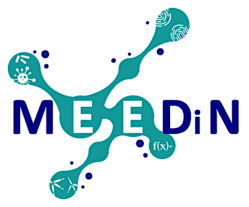Plasmodium vivax, the most prevalent human malaria parasite outside sub-Saharan Africa, represents an interesting model to study how pathogens adapt themselves to new environments. Indeed, the evolutionary history of this parasite is characterized by a succession of several colonization events on different primate species but also on different human populations. Very likely of Asian or African origin, P. vivax is indeed now present in almost all inter-tropical regions that it colonized more or less recently following human migrations. In the Americas, two events of colonization happened: (i) the first one when P. vivax arrived and infected new human populations and (ii) the second one with the transfer of P. vivax from humans to American monkeys, which gave rise to a new species genetically very close to P. vivax, named Plasmodium simium. During these colonisation events, P. vivax got exposed to new conditions in different vector species, in distinctive human populations and in different American monkey species. All these conditions likely exerted selective pressures on its genome to which it had to adapt by evolving towards new phenotypes and thus new genotypes.
One way to reconstruct the evolutionary history and predict genetic adaptation of parasites to new environments is to analyse whole genomes. Concerning P. vivax, although hundreds of strains from different parts of the world have been sequenced, genetic information about this parasite is still missing from several south American countries, mostly from the African continent (only few genomes have been published, with one from Mauritania, 4 from Madagascar and about 30 from Ethiopia) and from Eurasia (i.e. Turkey, Armenia, Azerbaidjan etc.). For P. simium, no genome has been yet published. Currently, the available genetic data are thus insufficient to robustly test evolutionary scenarios and study genetic adaptation of these parasites to new environments. Thus, one innovative aspect of this project will be to complete these last pieces of this “puzzle” by generating 372 genomes of P. vivax from missing countries in South America (N=69), Africa (N=189) and Eurasia (N=114) and to sequence the first P. simium genomes from other countries than Brazil (N=28).
GENERAL QUESTIONS. What is the evolutionary history of these parasites (P. vivax and P. simium) in the Americas? How, when and through which routes did they colonise the New World? How did they adapt to these new environments (new human populations, new vector species and new host species (Plathirrini monkeys))? Which genes have been involved? Project funding: NA. [Photo credit: Pixabay, Pexels)..
Project funding: ANR EVODRUG (16-CE36-0001-01) 2016-2021
[Photo credit: Rivero lab]
ONGOING PROJECTS

Collaborators : Franck Prugnolle (CREES, MIVEGEC), Michael Fontaine (CREES, MIVEGEC), Josquin Daron (MIVEGEC), Céline Arnathau (CREES, MIVEGEC), Patrick Durand (CREES, MIVEGEC), Andrea Chaves (Universidad of Costa Rica, Costa Rica) and Camila Gonzalez Rosas (Universidad de Los Andes, Colombia). Students : Clarice Moulin (PhD student, 2020-2023) and Soledad Santillan (Master 2 student, 2020)
learn more ...

Collaborators : Céline Arnathau (CREES, MIVEGECE), and Anne Boissière (MIVEGEC) )
learn more ...
A complementary in-depth molecular and functional analysis of genes involved in the adaptation of parasites to new environments is indispensable to provide a better understanding of how Plasmodium parasites adapt to different hosts. Functional experiments that directly measure the fitness effects of each mutation (and combinations of mutations) in each gene are fundamental to demonstrate adaptation and more data are needed. Of particular interests in Plasmodium parasites are the genes that govern host cell recognition (receptor) and entry by the parasite (ligand), specifically the RBC invasion. P. vivax, like the other malaria parasites, obligatorily infects at one stage of its life cycle the red blood cells (RBCs), with a preference for reticulocytes, or immature RBCs of its host. The success of this step determines whether P. vivax is able to infect a particular host or not, this project will thus focus specifically on RBCs invasion. The general goal will be to analyse the functional role of parasite ligands involved in RBCs invasion in the adaptation to different host species (humans, chimpanzees and gorillas). Published comparative genomic works and unpublished preliminary results obtained by myself this year allowed the identification of several proteins detected under positive selection, including some proteins involved in RBC invasion (such as Reticulocyte Binding Proteins, and PvDuffy Binding Protein, etc.). I thus propose to analyse these proteins as well as the parasite ligands involved in RBC invasion. Project funding: ANR T-ERC EVAD [Photo credit: Rougeron Virginie; Rosettes of Gorilla gorilla erythrocytes and COS-7 expressing PvDBP1 from P. vivax]

Collaborators: Ana Rivero (CREES, MIVEGEC, Montpellier), Carine Brouat, Nathalie Charbonnel and Laurent Granjon (CBGP, Montpellier), Larson Boundenga and Barthélémy Ngoubangoye (CIRMF, Franceville) and Boris Makanga (IRET, Franceville)
learn more ...
Host shifts are key processes in the evolution and diversification of host-parasite interactions and, as such, are considered to be one of the leading causes of the emergence of new infectious diseases and of the toll they impose on the health of humans, livestock and wildlife. The aim of this project is to study host shifts in rodent malaria (Plasmodium) parasites.
In natura , rodent malaria distribution is limited to the Congo Basin its host range seems to be largely restricted to one main host species, the thicket rat inhabiting the lowland tropical forests (Grammomys poensis). Preliminary results obtained by Franck Prugnolle’s group from Gabon, have demonstrated the natural circulation of rodent malaria across a large range of wild rodent species in sylvatic environments. More surprisingly, however, his group has also detected a high prevalence of rodent malaria infections in house mice in some rural villages. The house mouse was introduced into coastal areas of the African continent with the arrival of the European settlers and has since expanded its range, capturing new local pathogens along the way including rodent malaria agents in Gabon.
The project aims are to reply to the following questions: How and in which habitat this host shift from the native to the invasive rodent (the house mouse) occurred? What mosquito species have played a role of bridge between the natural sylvatic hosts and the invasive human-commensal host? How has the parasite adapted genetically and phenotypically to the new host and how has the host in turn responded to this new parasite species?
Funding: ANR MICETRAL
[Photo credit : B Dupont]

HUMANI : Contacts among wildlife, livestock & human in Africa and Infectious Risk
How Climate change modify interactions among wildlife, livestock and human in hot spot of biodiversity in Africa? Which are the consequences for infectious diseases?
learn more ...
Study at the interface between communal and protected areas in Zimbabwe PROJECT SYNTHESIS : The HUM-ANI project proposes to address increased infectious diseases’ threats and multi-hosts transmission in a context of climate change and biodiversity erosion in Austral African socio-ecosystems. Climate is changing and the African continent where temperatures are rising faster than the global rate will be particularly affected notably by severe drought and an increase in high-intensity rainfall events. It could result in significant losses of African plant species and of over 50 % bird and mammal species by 2100. Conservation movements have raised but these efforts seem to be inefficient. For instance, the population abundance of large mammals in Africa has declined by 59% between 1970 and 2005. From the “nature for itself” before 1970, conservation strategies changed from 2010 to a new fad based on the coexistence of “people and nature” in socio-ecosystems where sustainable interactions between human and nature are now promoted. However, the risks for wildlife, livestock and human in term of infectious diseases in this context of species extinctions, climate change and resources limitation are not well understood and predicted in the scientific literature. Addressing the consequences of the extinction of 1 million species for infectious diseases’ dynamics is thus crucial. Multi-species transmission is a key process in the emergence, spread and distribution of many infectious diseases (emergent or endemic) of humans and animals (domestic or wild). The predicted increase in aridity in Southern Africa will likely decrease primary production and make resource availability in space and time (surface water and forage) more uncertain. The increasing spatial overlap between pristine and agricultural environments, and the collapse of biodiversity are likely to redistribute inter-specific contact patterns and affect species jump processes. Where to go when the availability of water and grass decreases? Are protected Areas a refuge? How will interactions between humans, domestic & wild animals be impacted by climate change? What are the consequences for infectious diseases dynamics? The HUM-ANI project aims to: characterize the community and movements of hosts in contacts (wild, domestic animals & humans) at the interface between protected and communal areas in three socio-ecosystems (SE) under differing climate conditions monitor the spatio-temporal dynamics of a marker of transmission (i.e. Foot and Mouth disease) in the multi hosts community model how loss of biodiversity, increased temperatures and decreased rainfall are likely to modify the host contact networks and the resulting infectious diseases risks for wildlife, livestock and humans. Video sum up Version française : « HUM-ANI : Le rôle de la biodiversité dans l'émergence de maladies infectieuses » https://youtu.be/yoLA4vG-Moc · Version anglaise : “HUM-ANI: Biodiversity's role in the emergence of infectious diseases” https://youtu.be/HYC9u1eIx74

Collaborators: Josquin Daron (MIVEGEC), Franck Prugnolle (CREES, MIVEGEC), Michael Fontaine (CREES, MIVEGEC), Céline Arnathau (CREES, MIVEGEC), Patrick Durand (CREES, MIVEGEC), Anne Boissière (MIVEGEC).
learn more ...
Plasmodium vivax is the most prevalent and widespread human malaria parasite, with almost three billion people living at risk of infection. With the discovery of its closest genetic relatives in African great apes (Plasmodium vivax-like), the origin of P. vivax has been proposed to be located in the sub-Saharan African area. However, the limited number of genetic markers and samples investigated questioned the robustness of this result. Here, we examined the population genomic variation of 447 human P. vivax strains and 19 ape P. vivax-like strains originating from 24 different countries across the world. We identified 2,005,455 high quality single-nucleotide polymorphism loci allowing us to conduct an extensive characterization to date of P. vivax worldwide genetic variation. Phylogenetic relationships between human and ape Plasmodium revealed that P. vivax is a sister clade of P. vivax-like, not included within the radiation of P. vivax-like. By investigating a variety of aspects of P. vivax variation, we identified several striking geographical patterns in summary statistics as function of increasing geographic distance from Southeast Asia, suggesting that P. vivax may derived from serial founder effects from a single origin located in Asia.
Funding: ANR T-ERC EVAD
[Photo credit : Freepik]
RELEVANT PUBLICATIONS Click here for the full list

click for abstract ...
More than 200 million malaria clinical cases are reported each year due to Plasmodium vivax, the most widespread Plasmodium species in the world. This species has been neglected and understudied for a long time, due to its lower mortality in comparison with Plasmodium falciparum. A renewed interest has emerged in the past decade with the discovery of antimalarial drug resistance and of severe and even fatal human cases. Nonetheless, today there are still significant gaps in our understanding of the population genetics and evolutionary history of P. vivax, particularly because of a lack of genetic data from Africa. To address these gaps, we genotyped 14 microsatellite loci in 834 samples obtained from 28 locations in 20 countries from around the world. We discuss the worldwide population genetic structure and diversity and the evolutionary origin of P. vivax in the world and its introduction into the Americas. This study demonstrates the importance of conducting genome-wide analyses of P. vivax in order to unravel its complex evolutionary history.
Read more
click for abstract ...
Plasmodium falciparum, the most virulent agent of human malaria, shares a recent common ancestor with the gorilla parasite Plasmodium praefalciparum. Little is known about the other gorilla- and chimpanzee-infecting species in the same (Laverania) subgenus as P. falciparum, but none of them are capable of establishing repeated infection and transmission in humans. To elucidate underlying mechanisms and the evolutionary history of this subgenus, we have generated multiple genomes from all known Laverania species. The completeness of our dataset allows us to conclude that interspecific gene transfers, as well as convergent evolution, were important in the evolution of these species. Striking copy number and structural variations were observed within gene families and one, stevor, shows a host-specific sequence pattern. The complete genome sequence of the closest ancestor of P. falciparum enables us to estimate the timing of the beginning of speciation to be 40,000–60,000 years ago followed by a population bottleneck around 4,000–6,000 years ago. Our data allow us also to search in detail for the features of P. falciparum that made it the only member of the Laverania able to infect and spread in humans.
Read more
click for abstract ...
About 60% of emerging infectious diseases in humans are of zoonotic origin. Their increasing number requires the development of new methods for early detection and monitoring of infectious agents in wildlife. Here, we investigated whether blood meals from hematophagous flies could be used to identify the infectious agents circulating in wild vertebrates. To this aim, 1230 blood-engorged flies were caught in the forests of Gabon. Identified blood meals (30%) were from 20 vertebrate species including mammals, birds and reptiles. Among them, 9% were infected by different extant malaria parasites among which some belonged to known parasite species, others to new parasite species or to parasite lineages for which only the vector was known. This study demonstrates that using hematophagous flies as 'flying syringes' constitutes an interesting approach to investigate blood-borne pathogen diversity in wild vertebrates and could be used as an early detection tool of zoonotic pathogens.
Read more
click for abstract ...
Flow cytometry and cell sorting are powerful tools enabling the selection of particular cell types within heterogeneous cell mixtures. These techniques, combined with whole genome amplification that non-specifically amplify small amounts of starting DNA, offer exciting new opportunities for the study of malaria genetics. Among them, two are tested in this paper: (1) single cell genotyping and (2) parasite DNA purification for subsequent whole genome sequencing using shotgun technologies. The method described allows isolation of Plasmodium falciparum trophozoites, genotyping and whole genome sequencing from the blood of infected patients. For trophozoite isolation, parasite and host nuclei are stained using propidium iodide (PI) followed by flow cytometry and cell sorting to separate trophozoites from host cells. Before genotyping or sequencing, whole genome amplification is used to increase the amount of DNA within sorted samples. The method has been specifically designed to deal with frozen blood samples. The results demonstrate that single trophozoite genotyping is possible and that cell sorting can be successfully applied to reduce the contaminating host DNA for subsequent whole genome sequencing of parasites extracted from infected blood samples.
Read more
click for abstract ...
Plasmodium reichenowi, a chimpanzee parasite, was until very recently the only known close relative of Plasmodium falciparum, the most virulent agent of human malaria. Recently, Plasmodium gaboni, another closely related chimpanzee parasite, was discovered, suggesting that the diversity of Plasmodium circulating in great apes in Africa might have been underestimated. It was also recently shown that P. reichenowi is a geographically widespread and genetically diverse chimpanzee parasite and that the world diversity of P. falciparum is fully included within the much broader genetic diversity of P. reichenowi. The evidence indicates that all extant populations of P. falciparum originated from P. reichenowi, likely by a single transfer from chimpanzees. In this work, we have studied the diversity of Plasmodium species infecting chimpanzees and gorillas in Central Africa (Cameroon and Gabon) from both wild-living and captive animals. The studies in wild apes used noninvasive sampling methods. We confirm the presence of P. reichenowi and P. gaboni in wild chimpanzees. Moreover, our results reveal the existence of an unexpected genetic diversity of Plasmodium lineages circulating in gorillas. We show that gorillas are naturally infected by two related lineages of parasites that have not been described previously, herein referred to as Plasmodium GorA and P. GorB, but also by P. falciparum, a species previously considered as strictly human specific. The continuously increasing contacts between humans and primate populations raise concerns about further reciprocal host transfers of these pathogens.
Read morePHOTO GALLERY
Montpellier



